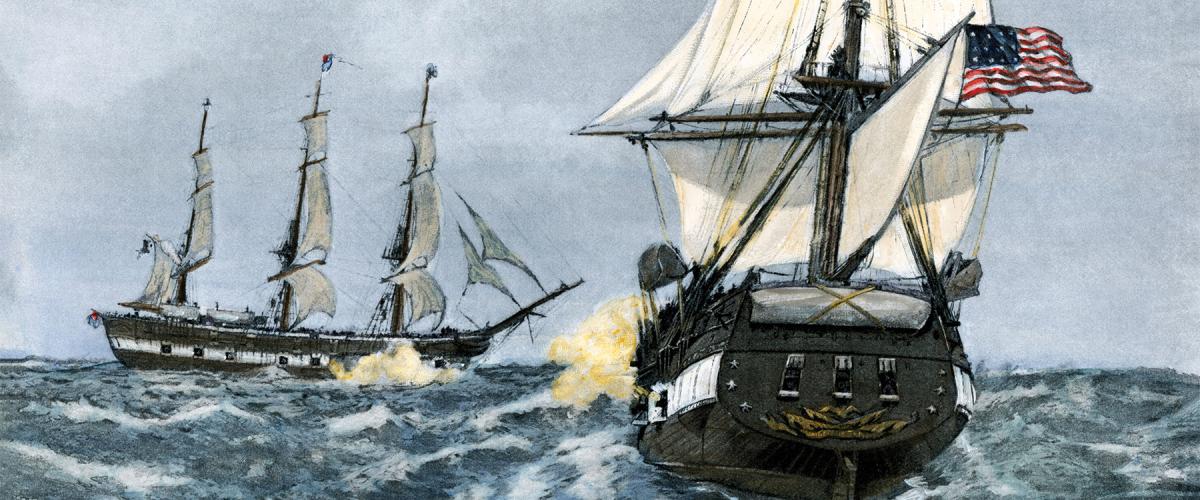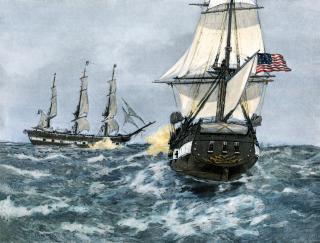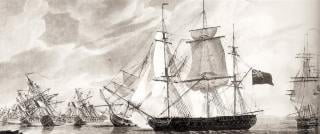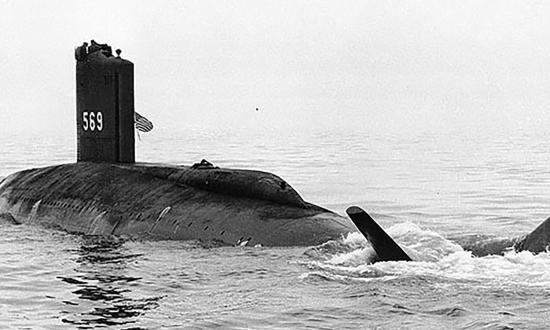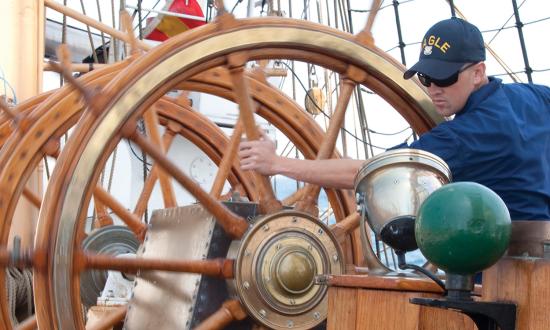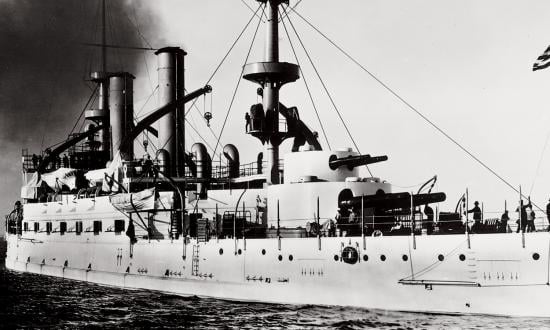The word frigate originally was a generic term to describe any lightly armed, fast, and maneuverable warship. To the 16th-century Spanish, it was a type of galley. In 17th-century Dunkirk, it referred to a small sailing privateer; while in the Dutch Navy a frigate was any oceangoing warship carrying fewer than 40 guns. But during the 18th century, the term came to be applied to a very specific type of vessel.
At the start of the 1700s, the standard small warship was a short, not particularly fast, two-decked vessel. The 1719 Royal Navy Establishment laid out two such types. There were fifth-rates, which carried 30 to 40 guns in full batteries on their two decks, generally 12-pounders on the lower deck and 6-pounders on the deck above. Below these were sixth-rates, the smallest rated warships, with 20 to 24 small 6-pounder guns, mostly carried on the upper deck. The lower deck was pierced with ports for a combination of additional guns and sweeps (long oars to be used if the wind failed). Although not particularly swift or powerful, these ships were deemed adequate for commerce protection, suppression of piracy, and general patrol work. Their main disadvantage was that they carried their lower guns so close to the water that they could be used only in benign weather. But in the years of peace that followed the Treaty of Utrecht in 1713, there was little impetus to review their design.
Change was to come, however, in response to developments in France. During the 1730s the reformer Jean-Frédéric Phélypeaux—Count of Maurepas and Secretary of State for the Navy from 1723 to 1749—overhauled French naval strategy. Lacking the resources to match the Royal Navy directly in battle, Maurepas decided to rebuild the navy to focus on supporting France’s colonial expansion overseas, while in Europe he would attack Britain’s trade through guerre de course (commerce raiding). He would achieve this second objective through a combination of small warships and privateers, and it was this that led to the development of the frigate.
The first true frigate was the Medée, built in Brest by the innovative constructor Blaise Ollivier in 1741. He retained the two-deck format of previous small warships but made the upper deck the main structural one. This meant it was strong enough to carry a more powerful armament—in this case, 26 8-pounders—high enough above the surface of the sea to operate in all weathers. The lower deck was given over to crew accommodation, so it no longer had any ports. This meant it could be moved down to the level of the waterline, reducing the amount of topside and markedly improving ship-handling. Weatherly, fast, and yet well armed, the Medée could outrun any ship she could not defeat and defeat any ship she could not outrun—a mantra that came to define the 18th-century frigate.
The Medée became the inspiration behind many large privateers, as well as a class of 30 frigates ordered for the French Navy based on her lines. In 1744 France joined the ongoing War of the Austrian Succession (known as King George’s War in the United States), and her new frigates were unleashed to attack British commerce. It quickly became clear that the Royal Navy’s existing small warships were no match for these new opponents, and, as the loss of merchant ships rose, so did the clamor for action among the maritime lobby.
The British Admiralty’s response was to abandon the existing establishment ships and replace them with British frigates built to match the new French design. An early advocate was Rear Admiral George Anson. When he first encountered a captured example—the Tygre, taken off Ushant—he wrote to the First Sea Lord, urging him “to direct Mr. Slade the Builder at Plymouth to take off the body of the French Tyger [sic] with the utmost exactness, and that two frigates may be ordered to be built with all possible dispatch, of her dimensions.” Once the benefits of the new design were understood, the Royal Navy began building frigates to its own strategic requirements, with deeper holds and more solid construction to be able to operate for longer periods at sea.
Soon all navies were reequipping with the new style of warship, and an arms race began with more powerful examples ordered to match the latest developments in a rival’s fleet. The first classes of Royal Navy frigates were 28s, armed with 9-pounders. By the Seven Years’ War, these were being replaced by 32-gun frigates armed with 12-pounders. During the American Revolution, still larger frigates appeared—36s, 38s, and even 40s, armed with 18-pounders.
Arguably frigates were the most useful warships of the 18th century. Their original role of convoy protection and commerce raiding persisted, but they were soon used in other roles, too. Their speed made them invaluable as agile scouts for the more ponderous battle squadrons—Vice Admiral Horatio Nelson called them “the eyes of the fleet” and frequently complained about not having enough. Once frigates had located an opponent and battle was joined, they still had a role to play. Positioned to windward (clear of the smoke) they served as repeating stations for signals, permitting orders from a flagship to be transmitted quickly. After the action, frigates frequently came to the aid of crippled ships-of-the-line. Both the British first-rates at the Battle of Trafalgar (HMS Victory and Royal Sovereign) might have perished in the storm that followed had frigates not towed them off a dangerous lee shore.
They were highly successful in aggressive roles, too. More weatherly and with shallower drafts than ships-of-the-line, frigates could operate closer inshore, making them valuable for raiding. In 1810, the British frigate Imperieuse, under the command of Captain Thomas Lord Cochrane, was detached to raid the Mediterranean coast of Spain. During a seven-month cruise, the frigate destroyed nine shore batteries, burned down six signal posts, helped Spanish guerrillas capture a small fortress, destroyed numerous bridges, and on one occasion directly bombarded French troops marching along a coast road.
Frigates generally engaged other frigates in battle, but this was not always the case. In 1800 the frigate Penelope, commanded by Captain Henry Blackwood, engaged the huge French 80-gun Guillaume Tell for several hours. Blackwood succeeded in severely damaging his opponent’s masts and sails, permitting a pursuing Royal Navy squadron to overhaul and defeat her. Perhaps the most celebrated engagement between frigates and a ship-of-the-line was in 1797, when the British frigates Indefatigable and Amazon defeated the French 74 Droits de l’Homme in an epic battle fought at night, in a storm, on a lee shore. Only the Indefatigable (Captain Sir Edward Pellew) survived the battle.
The final evolution of the sailing frigate came not from Europe but from the New World. In 1794, the U.S. Congress passed an act authorizing the construction of six new frigates, three of which were to be of unprecedented size. This is considered by many naval historians to be the founding act of the U.S. Navy. The ships were authorized for the specific purpose of protecting U.S. commerce from the Barbary States of North Africa, which had taken the lack of an effective U.S. Navy as an open invitation to attack American merchant ships with impunity. The size of the three “super-frigates” (the Constitution, United States, and President) was decided on to match the most powerful Algerian warships they were likely to encounter. As a result, by accident or design, the U.S. Navy had equipped itself with vessels that were superior to every frigate operated by the European navies.
This became apparent with the onset of the War of 1812. The Constitution was the first of the U.S. Navy’s new breed of frigates into action when she defeated the Royal Navy frigate Guerriere. Although the two ships were nominally the same type, it was an unequal fight. The American ship was one-third bigger, with proportionally thicker sides to protect her larger crew. At 175 feet long and 44 feet broad, the Constitution’s gun deck was similar in size to that of a Royal Navy 74, which allowed her to carry a main battery of 24-pounders against her opponent’s 18-pounders. With more and bigger guns, “Old Ironsides” could deliver a broadside that was one-third heavier. The evolution of the 18th-century frigate was complete.



